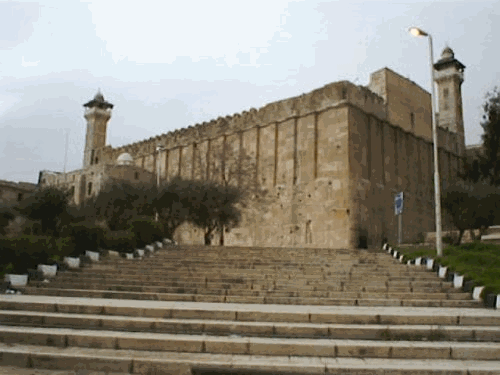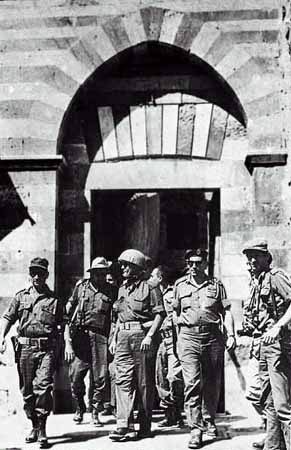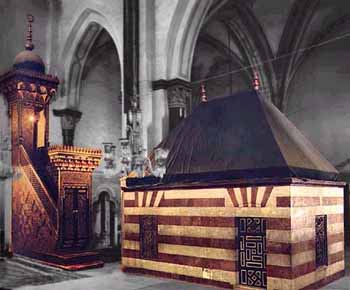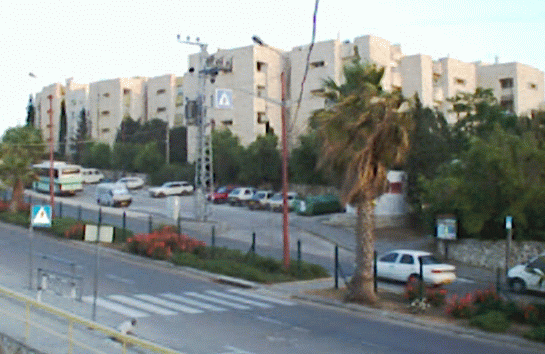Hebron
Like Jerusalem, 23 miles to its north, the ancient city ofHebron stirs deep religious and political passions, and has been the scene of heightened tension between Jews and Arabs for much of the last century.
Hebron is revered as one of the four holiest places in Judaism (along with Jerusalem, Safed and Tiberias) and Jews had lived continously there for centuries until the small community was forced out after brutal massacres led by Arab residents in the early 20th century. After Israel recaptured the West Bank during the Six Day War in 1967, a number of Jewish families reestablished the community near the ancient Tomb of the Patriachs.
As part of various peace agreements with the Palestinians, the Israeli government has withdrawn its presence from the majority of the city and now allows it to be administered by the Palestinian Authority.
Though the site of conflict during the Palestinian War from 2000 to 2005, the Jewish area of Hebron is now relatively safe and tourists are free to visit the community and the Jewish biblical sites under the guarding eye of the Israel Defense Forces.
History
The Hebrew word "Hebron" is derived from the Hebrew word for "friend" (haver), a description for the Patriarch Abraham, who was considered to be the friend of God. The Arabic "Al- Khalil" — literally "the friend" — has a nearly identical derivation, and also refers to the PatriarchAbraham (Ibrahim), whom Muslims similarly describe as the friend of God.
Hebron, which rises 3,050 feet (926 meters) above sea level, has a long and rich Jewish history. It was one of the first places where the Patriarch Abraham resided after his arrival in Canaan. King David was anointed in Hebron, where he reigned for seven years. One thousand years later, during the first Jewish revolt against the Romans, the city was the scene of extensive fighting. Jews lived in Hebron almost continuously throughout the Byzantine, Arab, Mameluke and Ottoman periods. It was only in 1929 — as a result of a murderous Arab pogrom in which 67 Jews were murdered and the remainder were forced to flee — that the city became temporarily "free" of Jews.
Following the creation of the State of Israel in 1948, and the invasion by Arab armies, Hebron was captured and occupied by the Jordanian Arab Legion. During the Jordanian occupation, which lasted until 1967, Jews were not permitted to live in the city, nor -- despite the Armistice Agreement -- to visit or pray at the Jewish holy sites in the city. Additionally, the Jordanian authorities and local residents undertook a systematic campaign to eliminate any evidence of the Jewish presence in the city. They razed the Jewish Quarter, desecrated the Jewish cemetery and built an animal pen on the ruins of the Avraham Avinu synagogue.
After the 1967 Six-Day War, the Jewish community of Hebron was re-established. On April 4, 1968, a group of Jews registered at the Park Hotel in the city. The next day they announced that they had come to re- establish Hebron's Jewish community. The actions sparked a nationwide debate and drew support from across the political spectrum. After an initial period of deliberation, Prime Minister Levi Eshkol's Labor-led government decided to temporarily move the group into a near-by IDF compound, while a new community -- to be called Kiryat Arba -- was built adjacent to Hebron. The first 105 housing units were ready in the autumn of 1972.
The Jewish community in Hebron itself was re-established permanently in April 1979, when a group of Jews from Kiryat Arba moved into Beit Hadassah. Following a deadly terrorist attack in May 1980 in which six Jews returning from prayers at the Tomb of the Patriarchs were murdered, and 20 wounded, Prime Minister Menachem Begin's Likud-led government agreed to refurbish Beit Hadassah, and to permit Jews to move into the adjacent Beit Chason and Beit Schneerson buildings in the old Jewish Quarter. An additional floor was built on Beit Hadassah, and 11 families moved in during 1986. Over the last two decades, many other Jewish properties and buildings in Hebron have been refurbished and rebuilt.
Religious Significance
The Cave of Machpelah, or Tomb of the Patriarchs, is the world's most ancient Jewish site and the second holiest place for the Jewish people, after the Temple Mount in Jerusalem. The cave was purchased by Abraham as a burial place for his wife Sarah some 3,700 years ago, along with the trees and field adjoining it, the first recorded transaction of a Hebrew buying land in Canaan (Genesis 23). Abraham, Isaac, Jacob, Rebecca, and Leah were all later buried in the same place. These are considered the patriarchs and matriarchs of the Jewish people. The only one who is missing is Rachel, who was buried near Bethlehem where she died in childbirth. Muslims believe that Joseph is also buried here, though Jews think he was buried in Nablus.
The building covering the cave was constructed roughly two thousand years ago by Herod. The 40-60 foot high walls are similar to those of the Temple Mount. Since Herod's time, the structure has been used by foreign conquerors as a shrine to their own religions. Thus, the Byzantines andCrusaders transformed it into a church and the Muslims converted it a mosque. About 700 years ago, the Mamelukes conquered Hebron, declared the structure a mosque and forbade entry to Jews, who were not allowed past the seventh step on a staircase outside the building.
The structure is divided into three rooms: Ohel Avraham, Ohel Yitzhak, and Ohel Ya'akov. Presently Jews have access to Ohel Yitzhak, the largest room, only 10 days a year. The tombs are all underground. The visible parts are covered with tapestries and cenotaphs. A 700-year-old stained-glass window adorns the tomb of Jacob and Leah, which are in an adjoining courtyard opposite the monuments to Abraham and Sarah.
Hebron contains several other sites of Jewish religious and historical significance, including the Tombs of Othniel Ben Kenaz (the first Judge of Israel) and Avner Ben Ner (general and confidante to Kings Saul andDavid), and Ruth and Jesse (great-grandmother and father, respectively, of King David). Victims of the 1929 pogrom, as well as prominent rabbinical sages and community figures, are buried in Hebron's ancient Jewish cemetery.
In recent years, Hebron has been the site of many violent incidents, two of which stand out. In May 1980, Palestinian terrorists murdered six Jewish yeshiva students and wounded 20 others, who were returning from prayers at the Tomb of the Patriarchs. In February 1994, a Jew named Baruch Goldstein opened fire on Muslim worshippers at the Tomb, killing 29 and wounding 125.
Hebron Today
Hebron is home to approximately 120,000 Arabs, 500 Jews and a handful of Christians. On the outskirts of the city are glass-blowing, pottery and woodworking shops and, near the center of town, a large visitor center. The Arab market is similar to those elsewhere, but given the volatility of the city, visitors are usually discouraged from going there. The city also has a small museum of artifacts used in the area through the centuries.
Though Israel regained control of Hebron in 1967, the Cave of Machpelah has remained under the authority of the Muslim Waqf (Religious Trust), which continues to restrict Jewish access. No visitors are allowed inside during Muslim prayer times, Fridays or Muslim holidays.
Following the signing of the Interim Agreement on September 28, 1995, authority over most civilian matters concerning Hebron's Arab residents was transferred from the IDF Civil Administration to the Palestinian Authority and/or the (Arab) Municipality of Hebron. Those services which remained the responsibility of the Civil Administration were transferred to thePalestinian Authority and the Municipality following the IDF redeployment in Hebron in 1997. Since then, the Palestinians have controlled roughly 80 percent of the city and Israel 20 percent (including the area where Jews are living). International observers patrol the city to help monitor the situation.
At the time of Abraham, the Canaanite town in this place was known as Kiryat Arba. The name was later changed to Hebron (Joshua 14:15). Today, Kiryat Arba is the name of a suburb of Hebron, five minutes from the Cave of Machpelah and the heart of the city. Established in 1971, Kiryat Arba was the first renewed Jewish community in Judea and Samaria. Today, Kiryat Arba is home to more than 6,000 Jews who have a reputation for being among the most zealous defenders of the idea that Jews have a right to live in the West Bank. The town has educational institutions from pre-nursery school through post-High school, modern medical facilities, shopping centers, a bank and post office.
Hebron Tomb of the Patriarchs Like Jerusalem, 23 miles to its north, the ancient city of Hebron stirs deep religious and political passions, and has been the scene of heightened tension between Jews and Arabs for much of the last century. Hebron is revered as one of the four holiest places in Judaism (along with Jerusalem, Safed and Tiberias) and Jews had lived continously there for centuries until the small community was forced out after brutal massacres led by Arab residents in the early 20th century. After Israel recaptured the West Bank during the Six Day War in 1967, a number of Jewish families reestablished the community near the ancient Tomb of the Patriachs. As part of various peace agreements with the Palestinians, the Israeli government has withdrawn its presence from the majority of the city and now allows it to be administered by the Palestinian Authority. Though the site of conflict during the Palestinian War from 2000 to 2005, the Jewish area of Hebron is now relatively safe and tourists are free to visit the community and the Jewish biblical sites under the guarding eye of the Israel Defense Forces. History The Hebrew word "Hebron" is derived from the Hebrew word for "friend" (haver), a description for the Patriarch Abraham, who was considered to be the friend of God. The Arabic "Al- Khalil" — literally "the friend" — has a nearly identical derivation, and also refers to the Patriarch Abraham (Ibrahim), whom Muslims similarly describe as the friend of God. Hebron, which rises 3,050 feet (926 meters) above sea level, has a long and rich Jewish history. It was one of the first places where the Patriarch Abraham resided after his arrival in Canaan. King David was anointed in Hebron, where he reigned for seven years. One thousand years later, during the first Jewish revolt against the Romans, the city was the scene of extensive fighting. Jews lived in Hebron almost continuously throughout the Byzantine, Arab, Mameluke and Ottoman periods. It was only in 1929 — as a result of a murderous Arab pogrom in which 67 Jews were murdered and the remainder were forced to flee — that the city became temporarily "free" of Jews. Following the creation of the State of Israel in 1948, and the invasion by Arab armies, Hebron was captured and occupied by the Jordanian Arab Legion. During the Jordanian occupation, which lasted until 1967, Jews were not permitted to live in the city, nor -- despite the Armistice Agreement -- to visit or pray at the Jewish holy sites in the city. Additionally, the Jordanian authorities and local residents undertook a systematic campaign to eliminate any evidence of the Jewish presence in the city. They razed the Jewish Quarter, desecrated the Jewish cemetery and built an animal pen on the ruins of the Avraham Avinu synagogue. Minister of Defense, Moshe Dayan, Commander of the Central Command, Uzi Narkis, and Gen. Rechavam Ze'evi visiting the gate of the Tomb of the Patriarchs (WZO) After the 1967 Six-Day War, the Jewish community of Hebron was re-established. On April 4, 1968, a group of Jews registered at the Park Hotel in the city. The next day they announced that they had come to re- establish Hebron's Jewish community. The actions sparked a nationwide debate and drew support from across the political spectrum. After an initial period of deliberation, Prime Minister Levi Eshkol's Labor-led government decided to temporarily move the group into a near-by IDF compound, while a new community -- to be called Kiryat Arba -- was built adjacent to Hebron. The first 105 housing units were ready in the autumn of 1972. The Jewish community in Hebron itself was re-established permanently in April 1979, when a group of Jews from Kiryat Arba moved into Beit Hadassah. Following a deadly terrorist attack in May 1980 in which six Jews returning from prayers at the Tomb of the Patriarchs were murdered, and 20 wounded, Prime Minister Menachem Begin's Likud-led government agreed to refurbish Beit Hadassah, and to permit Jews to move into the adjacent Beit Chason and Beit Schneerson buildings in the old Jewish Quarter. An additional floor was built on Beit Hadassah, and 11 families moved in during 1986. Over the last two decades, many other Jewish properties and buildings in Hebron have been refurbished and rebuilt. Religious Significance The Cave of Machpelah, or Tomb of the Patriarchs, is the world's most ancient Jewish site and the second holiest place for the Jewish people, after the Temple Mount in Jerusalem. The cave was purchased by Abraham as a burial place for his wife Sarah some 3,700 years ago, along with the trees and field adjoining it, the first recorded transaction of a Hebrew buying land in Canaan (Genesis 23). Abraham, Isaac, Jacob, Rebecca, and Leah were all later buried in the same place. These are considered the patriarchs and matriarchs of the Jewish people. The only one who is missing is Rachel, who was buried near Bethlehem where she died in childbirth. Muslims believe that Joseph is also buried here, though Jews think he was buried in Nablus. The building covering the cave was constructed roughly two thousand years ago by Herod. The 40-60 foot high walls are similar to those of the Temple Mount. Since Herod's time, the structure has been used by foreign conquerors as a shrine to their own religions. Thus, the Byzantines and Crusaders transformed it into a church and the Muslims converted it a mosque. About 700 years ago, the Mamelukes conquered Hebron, declared the structure a mosque and forbade entry to Jews, who were not allowed past the seventh step on a staircase outside the building. The tomb of Isaac (WZO) The structure is divided into three rooms: Ohel Avraham, Ohel Yitzhak, and Ohel Ya'akov. Presently Jews have access to Ohel Yitzhak, the largest room, only 10 days a year. The tombs are all underground. The visible parts are covered with tapestries and cenotaphs. A 700-year-old stained-glass window adorns the tomb of Jacob and Leah, which are in an adjoining courtyard opposite the monuments to Abraham and Sarah. Hebron contains several other sites of Jewish religious and historical significance, including the Tombs of Othniel Ben Kenaz (the first Judge of Israel) and Avner Ben Ner (general and confidante to Kings Saul and David), and Ruth and Jesse (great-grandmother and father, respectively, of King David). Victims of the 1929 pogrom, as well as prominent rabbinical sages and community figures, are buried in Hebron's ancient Jewish cemetery. In recent years, Hebron has been the site of many violent incidents, two of which stand out. In May 1980, Palestinian terrorists murdered six Jewish yeshiva students and wounded 20 others, who were returning from prayers at the Tomb of the Patriarchs. In February 1994, a Jew named Baruch Goldstein opened fire on Muslim worshippers at the Tomb, killing 29 and wounding 125. Hebron Today Hebron is home to approximately 120,000 Arabs, 500 Jews and a handful of Christians. On the outskirts of the city are glass-blowing, pottery and woodworking shops and, near the center of town, a large visitor center. The Arab market is similar to those elsewhere, but given the volatility of the city, visitors are usually discouraged from going there. The city also has a small museum of artifacts used in the area through the centuries. Though Israel regained control of Hebron in 1967, the Cave of Machpelah has remained under the authority of the Muslim Waqf (Religious Trust), which continues to restrict Jewish access. No visitors are allowed inside during Muslim prayer times, Fridays or Muslim holidays. Following the signing of the Interim Agreement on September 28, 1995, authority over most civilian matters concerning Hebron's Arab residents was transferred from the IDF Civil Administration to the Palestinian Authority and/or the (Arab) Municipality of Hebron. Those services which remained the responsibility of the Civil Administration were transferred to the Palestinian Authority and the Municipality following the IDF redeployment in Hebron in 1997. Since then, the Palestinians have controlled roughly 80 percent of the city and Israel 20 percent (including the area where Jews are living). International observers patrol the city to help monitor the situation. At the time of Abraham, the Canaanite town in this place was known as Kiryat Arba. The name was later changed to Hebron (Joshua 14:15). Today, Kiryat Arba is the name of a suburb of Hebron, five minutes from the Cave of Machpelah and the heart of the city. Established in 1971, Kiryat Arba was the first renewed Jewish community in Judea and Samaria. Today, Kiryat Arba is home to more than 6,000 Jews who have a reputation for being among the most zealous defenders of the idea that Jews have a right to live in the West Bank. The town has educational institutions from pre-nursery school through post-High school, modern medical facilities, shopping centers, a bank and post office. Continuity of Jewish PresenceHebron
Of all the ancient communities in Israel, none is more ancient than Hebron—the oldest Jewish community in the world. The first mention of Hebron is in Genesis, after the death of the Matriarch Sarah. Genesis 23 relates the story of Abraham approaching the Hittites in Hebron and asking to purchase an empty field in order to build a burial site for his wife (Genesis 23). After he paid for it—insisting on it, though the Hittites were willing to give it to him for free—he buried Sarah, and later, Abraham himself, along with Isaac, Rebecca, Jacob, and Leah were all buried there.
Hebron is mentioned dozens of time throughout the Old Testament. Judges 1 describes the conquest of Hebron, and later King David was anointed there (II Samuel 2:5). Even after the destruction of the First Temple, there still existed a Jewish population in Hebron, as described in Nehemia 11. King Herod, during his reign around 35 BCE, built a huge structure over the Tomb of the Patriarchs, the base of which still stands today. Jews continued to be a presence in the city, through the destruction of the Second Temple and the Jewish Revolts against the Romans.
There is archaeological evidence of synagogues from the Byzantine period. During the years of Seljuk conquest, in the 7th century, the Jews lived peacefully in Hebron as well. The Crusaders expelled the Jewish community in 1100, but the Jews returned during Mamluk rule.
In the 16th century, when Israel was under Ottoman rule, Jews fleeing from Spain arrived in Hebron and established the Avraham Avinu (Abraham our Father) synagogue. The community flourished during the Ottoman Empire, with many Diaspora Jews coming to settle in the city, despite occasional pogroms from the Arab population and an often shaky economic situation. In 1893, the Beit Hadassah building was constructed, which served as a clinic for the Jewish and Arab populations.
The Hebron community suffered during the First World War, as the young men were forcibly drafted into the Turkish army, and disease and poverty were rampant. Following the war, though, the community started to recover, and by 1929, the population had risen once again.
However, in 1929 the Jews in Hebron were the victims of a brutal, planned, and systematic attack by local Arabs. The Jews and Arabs in Hebron had more or less lived harmoniously, but during the 1920s, there were many incidents of Arabs harassing the Jews. In August of 1929, the Arabs, egged on by rumors that the Jews attacked local Arabs and cursed Mohammad, started rioting in the Old City of Jerusalem. The riots quickly spread, with the worst of the atrocities occurring in Hebron and Safed. Some of the local Arab families in Hebron saved Jews by hiding them in their houses. By the end, sixty-seven Jews had been massacred, including yeshiva students, women, and young children.
Some families attempted to move back to Hebron a few years later, but were evacuated by British forces in 1936 due to the Palestinian Arab National Revolt. This effectively ended Jewish presence in Hebron until after the 1967 Six Day War. (Following the 1948 War of Independence, the city fell under Jordanian control.)
After the Six Day War, Hebron was returned to Israeli control; since then, it remains closely linked to its neighbor,Kiryat Arba. In 1968, Rabbi Moshe Levinger moved into Hebron's Park Hotel with a number of other families, in an attempt to repopulate the city. After a year of attacks on the Jews, the government moved them to a nearby military base in Kiryat Arba. In 1979, the city was more permanently established when Levinger's wife, Miriam, led a controversial group and settled in Beit Hadassah. In 1980, six Jews were killed and twenty wounded when they were attacked by the Arabs on their way home from prayers on a Friday night. Following the attack, the government agreed to refurbish Beit Hadassah along with other buildings in the area.
Since 1997, Hebron has been divided into two areas, H1, under control of the Palestinian Authority, and H2, controlled by the Israeli military to protect the Jews living there. Violence from both sides has erupted in Hebron since the Oslo Accords. During the first and second Intifadas, the Jewish community was subject to many attacks. In 1994, Baruch Goldstein, a resident of Kiryat Arba, attacked and killed Muslim worshipers at the Tomb of the Patriarchs. After the Goldstein attack, security at the tomb has been shared by the IDF, which patrols the outside, and a special police unit, which secures the inside.
The post-1967 Jewish population in Hebron has been the subject of much controversy. Most recently, a group moved into the Beit Shalom house, but it was under much dispute, and the Israeli government evacuated those living there in 2008.
The town of Hebron is second only to Jerusalem in its holiness. The Jewish people laid claim to the city two millennia ago, when Abraham insisted on purchasing the plot of land. He must have known it was to be a stormy area.
|
Friday, July 31, 2015
Hebron - Tomb of the Patriarchs
Subscribe to:
Post Comments (Atom)




ReplyDeleteGeography of Israel:
Hebron
Geography: Table of Contents | Jerusalem | Tel Aviv
Print Friendly and PDF
Reference
History & Overview
Map of Hebron (2000)
Map of Hebron (1912)
History
The Hebron Massacre (1929)
The Hebron Protocol (1997)
Temporary International Presence (1997)
Sites & Attractions
Tomb of the Patriarchs (Machpelah Cave)
Kiryat Arba
Hebron Mountains